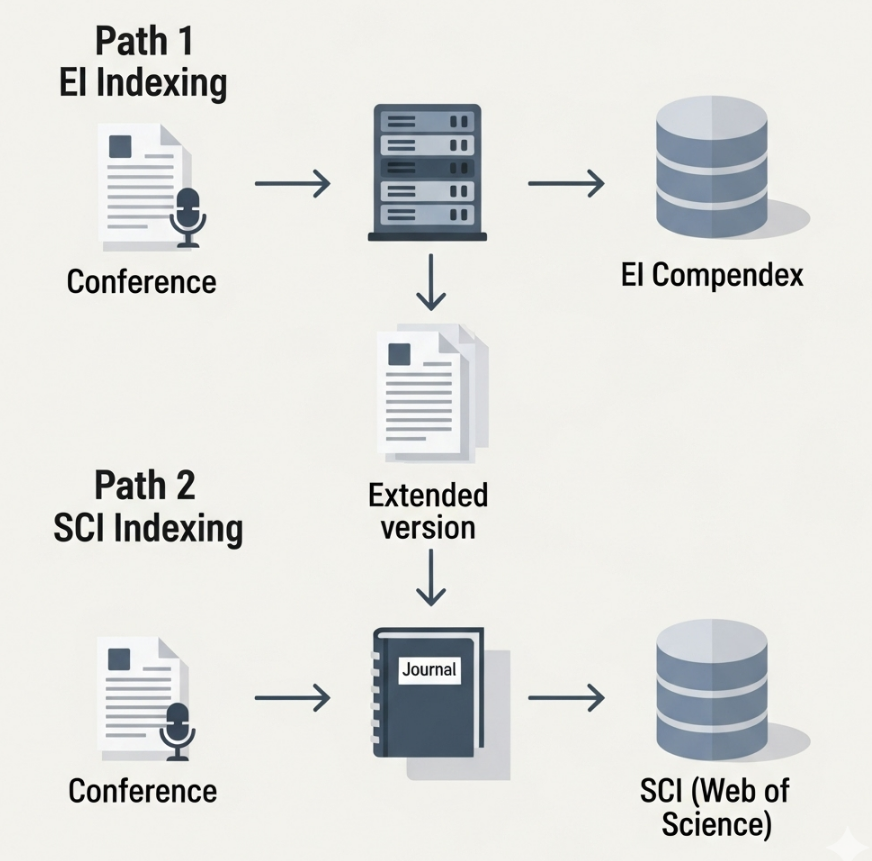

17 views||Release time: Aug 28, 2025
In the world of academic publishing, "EI" and "SCI" are frequently used as benchmarks for quality and prestige. For graduate students and early-career researchers, understanding what these terms mean is essential for making strategic decisions about where to publish your work.
However, there is a great deal of confusion, especially around the term "SCI conference." This guide will clarify what EI indexing means for a conference and explain the true meaning of SCI indexing in the academic world.

EI stands for Engineering Index. It is a comprehensive bibliographic database of scientific and technical engineering literature. Today, the core of EI is its database called Compendex, which is owned by Elsevier.
When a conference is described as "EI-indexed" or "indexed by Compendex," it means that the papers published in that conference's proceedings will be included in the Compendex database.
Why does EI indexing matter?
Mark of Quality: Reputable conferences must meet certain standards to have their proceedings accepted by EI. It serves as a baseline indicator of quality and peer-review rigor in the engineering field.
Visibility and Reach: Having your paper in the Compendex database increases its visibility to a global audience of engineering researchers, leading to more citations.
Institutional Requirements: Many universities, particularly in Asia, have graduation or performance evaluation requirements for their PhD and Master's students that specify publishing a certain number of EI-indexed papers.
How to Verify: Always check the conference's official website. A legitimate conference will proudly state its indexing status. You can also search for the conference's previous proceedings on the Engineering Village platform (which hosts Compendex) to verify their claims.
This is where the most common confusion arises.
SCI stands for Science Citation Index. It is a prestigious citation database, now owned by Clarivate Analytics. The modern, expanded version is the SCIE (Science Citation Index Expanded), which is part of the Web of Science (WoS) Core Collection.
The most critical point to understand is: SCI/SCIE almost exclusively indexes journals, not conference papers.
Therefore, the term "SCI Conference" is technically a misnomer and is often used incorrectly. A conference paper itself is not "SCI-indexed." When people refer to an "SCI conference," they usually mean one of the following scenarios:
Partnership with an SCI Journal: The conference has an official partnership with an SCI-indexed journal. The best papers presented at the conference will be invited to submit an extended and enhanced version for publication in a special issue of that journal.
Fast-Track Journal Submission: Organizers have arranged for high-quality conference papers to be recommended to an affiliated SCI journal for a "fast-tracked" peer-review process.
Implied Quality: The conference is so prestigious (e.g., top-tier events in computer science or medicine) that its papers are widely considered to be of "journal quality," and authors are expected to later extend them into full SCI journal articles.
In all these cases, it is the final, extended journal article that gets SCI-indexed, not the original conference paper. The conference simply acts as a pathway or feeder for SCI journal publication.
| Feature | EI (Compendex) | SCI (Web of Science) |
| Primary Content Type | Conference proceedings and journal articles | Overwhelmingly journal articles |
| Primary Subject Area | Broad Engineering and Applied Science | All major scientific disciplines |
| "Indexed Conference" | This is a direct and common practice. | This is an indirect term, usually meaning a pathway to an SCI journal. |
For researchers, especially in engineering, ensuring your target conference is EI-indexed is a straightforward way to guarantee a certain level of quality and meet institutional requirements.
When you see the term "SCI conference," investigate further. Look for specific information on the conference website about which SCI-indexed journals they are partnered with and what the process is for submitting an extended version. This distinction is crucial for accurately representing your publications and planning your academic career.